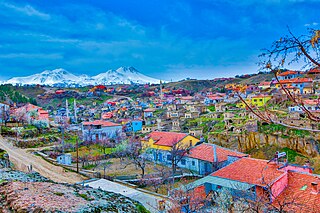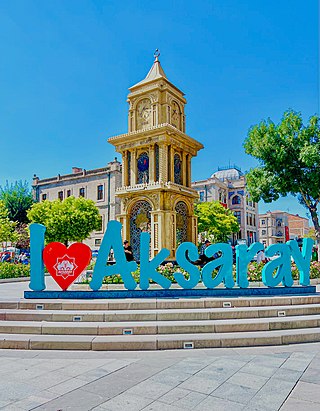
Osman I or Osman Ghazi was the founder of the Ottoman Empire. While initially a small Turkoman principality during Osman's lifetime, his beylik transformed into a vast empire in the centuries after his death. It existed until shortly after the end of World War I, when the sultanate was abolished.

A caravanserai was a roadside inn where travelers (caravaners) could rest and recover from the day's journey. Caravanserais supported the flow of commerce, information and people across the network of trade routes covering Asia, North Africa and Southeast Europe, most notably the Silk Road. Often located along rural roads in the countryside, urban versions of caravanserais were also historically common in cities throughout the Islamic world, and were often called other names such as khan, wikala, or funduq.

The Sultanate of Rûm was a culturally Turco-Persian Sunni Muslim state, established over conquered Byzantine territories and peoples (Rûm) of Anatolia by the Seljuk Turks following their entry into Anatolia after the Battle of Manzikert (1071). The name Rûm was a synonym for the medieval Eastern Roman Empire and its peoples, as it remains in modern Turkish. The name is derived from the Aramaic (romī) and Parthian (frwm) names for ancient Rome, via the Greek Ῥωμαῖοι (Romaioi).

Tokat is a city of Turkey in the mid-Black Sea region of Anatolia. It is the seat of Tokat Province and Tokat District. Its population is 163,405 (2022). It is located at the confluence of the Tokat River with the Yeşilırmak.

Aksaray Province is a province in central Turkey. Its adjacent provinces are Konya along the west and south, Ankara to the northwest, Niğde to the southeast, Nevşehir to the east, and Kırşehir to the north. Its area is 7,659 km2, and its population is 433,055 (2022). The provincial capital is the city of Aksaray.

Aksaray is a city in the Central Anatolia region of Turkey. It is the seat of Aksaray Province and Aksaray District. Its population is 247,147 (2021). In 2021 the province had an estimated population of 429,069 distributed over about 7,659 km2 (2,957 sq mi). The average elevation is 980 m (3,215 ft), with the highest point being Mt. Hasan at 3,268 m (10,722 ft).
Melike İsmetüddin Gevher Nesibe was an early 13th century princess of the Sultanate of Rum, the daughter of Kilij Arslan II and sister of Kaykhusraw I.

Turkish art refers to all works of visual art originating from the geographical area of what is present day Turkey since the arrival of the Turks in the Middle Ages. Turkey also was the home of much significant art produced by earlier cultures, including the Hittites, Ancient Greeks, and Byzantines. Ottoman art is therefore the dominant element of Turkish art before the 20th century, although the Seljuks and other earlier Turks also contributed. The 16th and 17th centuries are generally recognized as the finest period for art in the Ottoman Empire, much of it associated with the huge Imperial court. In particular the long reign of Suleiman the Magnificent from 1520 to 1566 brought a combination, rare in any ruling dynasty, of political and military success with strong encouragement of the arts.

The Alâeddin Mosque is the principal monument on Alaaddin Hill in the centre of Konya, Turkey. Part of the hilltop citadel complex that contained the Seljuk Palace, it served as the main prayer hall for the Seljuk Sultans of Rum and its courtyard contains the burial places of several of the sultans. It was constructed in stages between the mid-12th and mid-13th centuries. It is the largest of several Seljuk mosques to survive in Konya.
Ghiyath al-Dīn Me’sud ibn Kaykaus or Mesud II bore the title of Sultan of Rûm at various times between 1284 and 1308. He was a vassal of the Mongols under Mahmud Ghazan and exercised no real authority. Mesud died in 1308, the last of the Seljuks of Rum.
The Seljuk Empire, or the GreatSeljuk Empire, was a high medieval, culturally Turco-Persian, Sunni Muslim empire, established and ruled by the Qïnïq branch of Oghuz Turks. The empire spanned a total area of 3.9 million square kilometres from Anatolia and the Levant in the west to the Hindu Kush in the east, and from Central Asia in the north to the Persian Gulf in the south, and it spanned the time period 1037–1308, though Seljuk rule beyond the Anatolian peninsula ended in 1194.

Sa’d al-Din Köpek was a court administrator under two 13th century Seljuq Sultans of Rum and is known for his indirect role in the subjugation of the Sultanate of Rum by the Mongol Empire due to his disloyalty and aim for greater power during the turbulent 13th century in Anatolia.
Taşhan caravanserai, also known as the Hekimhani or Hekim Han, is located in the town of Hekimhan, near Malatya in Turkey. The building was built in 1218 under Sultan İzzettin Keykavus I of the Sultanate of Rum. Its builder was a doctor (hekim), and it was built as a commercial enterprise.

The Grand Mosque of Bursa is a historic mosque in Bursa, Turkey. It was commissioned by the Ottoman Sultan Bayezid I to commemorate his great victory at the Battle of Nicopolis and built between 1396 and 1399. The mosque is a major monument of early Ottoman architecture and one of the most important mosques in the city, located in the heart of the old city alongside its historic markets.

Anatolian Seljuk architecture, or simply Seljuk architecture, refers to building activity that took place under the Sultanate of Rum, ruled by an offshoot of the Seljuk dynasty that emerged from the Great Seljuk Empire alongside various other local dynasties. The Anatolian Seljuks patronized their own tradition of architecture whose surviving examples are generally found in present-day Turkey. Anatolian Seljuk architecture was eclectic and influenced by multiple traditions including Armenian, Byzantine, Iranian, and Syrian architecture. Unlike earlier Great Seljuk architecture to the east, their buildings were generally constructed in stone and featured significant stone-carved decoration as well as tile decoration. While the Seljuk Sultanate declined and ended in the late 13th century, architecture continued to flourish and diversify under the smaller Beylik states in Anatolia, which included the early Ottomans.

Sultan Han is a large and significant 13th-century Seljuk caravanserai located in the town of Sultanhanı, Aksaray Province, Turkey. It is one of the three monumental caravanserais in the neighbourhood of Aksaray and is located about 40 km (25 mi) west of Aksaray on the road to Konya.
Amasya Museum, also known as Archaeological Museum of Amasya, is a national museum in Amasya, northern Turkey, exhibiting archaeological artifacts found in and around the city as well as ethnographic items related to the region's history of cultural life. Established in 1958, the museum owns nearly twenty-four thousand items for exhibition belonging to eleven historic civilizations.

Buruciye Medrese or Buruciye Madrasah is a former medrese, in Sivas, Turkey. It was built during the reign of Seljuk sultan Gıyaseddin Keyhüsrev III in 1271.

Sultan Han is a historic Seljuk-era caravanserai in Turkey, located 47 km northeast of Kayseri on the road to Sivas, in an area also known as Tuzhisar. It was built between 1232 and 1237 CE by Sultan Ala ad-Din Kayqubad I.
Shams al-Din Altınapa or Atabey Altun Aba was a Seljuk vizier. He at first was a military commander under Kilij Arslan II and Süleyman Shah II. After Süleyman II died, he served his son, Giyaseddin Keyhüsrev I, and then later his son, Alaeddin Keykubad I. Kaykubad I later made him the atabey of his son, Gıyaseddin Keyhüsrev II, who was the last sultan he served before getting killed.














